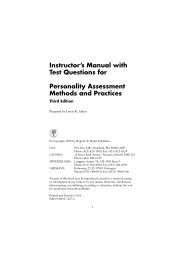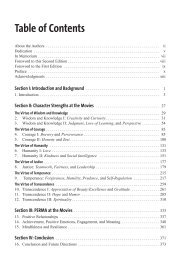Implicit Attitude Measures - ResearchGate
Implicit Attitude Measures - ResearchGate
Implicit Attitude Measures - ResearchGate
You also want an ePaper? Increase the reach of your titles
YUMPU automatically turns print PDFs into web optimized ePapers that Google loves.
Editorial<strong>Implicit</strong> <strong>Attitude</strong> <strong>Measures</strong>Melanie C. Steffens 1 and Kai J. Jonas 21 Friedrich Schiller University, Jena, Germany2 University of Amsterdam, The NetherlandsArguably, one of the most thriving research areas in currentpsychology is assessing attitudes and related constructs withimplicit measures, which we define as those indirect measuresthat rely on response latencies or other indices of spontaneoustrait association, the activation of action semantics,or even real behavior. This research area is united by ashared excitement about the discoveries enabled by thesemeasures, be they related to social attitudes and behavior,clinical disorders, consumer decisions, or self-representations,among others. As this enumeration suggests, in spiteof the common excitement about the new research questionsimplicit measures allow us to investigate, there is muchdiversity in this research. First of all, these approachesbridge subdisciplines of psychology traditionally characterizedby little cross-talk. Furthermore, the variety of implicitmeasures used is already broad and still growing, given variantsand implementations of these implicit measures in differentsamples and research approaches. Given this diversity,we deemed it appropriate to summarize research that focuseseither on the comparison of different implicit measures or onthe mechanisms underlying one of the measures. Suchknowledge is necessary and helpful to determine whichmeasure to employ in a given research context and also tobe aware of limitations of certain measures and advantagesof others. Thus, the articles collected in this special issuecompare two or more different implicit measures, or theyfocus on the measurement properties of one.One of the mostly used implicit measures, the <strong>Implicit</strong>Association Test (IAT; Greenwald, McGhee, & Schwartz,1998), was introduced in a way that would have allowedresearchers to implement it as if it was a standardized test.In spite of this, researchers not only used stimuli, numbersof trials, evaluation procedures, and other specifics differentfrom those suggested; but in the end, they even suggestedtheir own variants of IATs or implicit measures that keepcertain aspects of IATs while eliminating or adding others(e.g., De Houwer, 2003; Nosek & Banaji, 2001; Olson &Fazio, 2004; Sriram & Greenwald, 2009; Steffens,Kirschbaum, & Glados, 2008). As a first consequence, theanswer to the question how a ‘‘good’’ IAT should be constructedis not as clean and tidy anymore as it appeared in1998. As a second consequence of these methodologicaldebates IAT research now comprises a diversity at theexpense of addressing comparisons with other implicitmeasures (the implicit-explicit relation on the contrary hasbeen attended to, e.g., Hofmann, Gawronski, Gschwendner,Le, & Schmitt, 2005).Matters get much more complicated if we add otherimplicit measures to this cocktail, the most prominent onesamong them being based on priming effects (Fazio,Sanbonmatsu, Powell, & Kardes, 1986; Payne, Cheng,Govorun, & Stewart, 2005), but many recent ones basedon approach-avoidance reactions (see Reinecke, Becker, &Rinck, 2010). Whereas some research has systematicallycompared different implicit measures and found disturbingdiscrepancies among them (e.g., Bosson, Swann, &Pennebaker, 2000) and among the mechanisms underlyingthem (e.g., Gawronski & Bodenhausen, 2005; Wittenbrink,Judd, & Park, 2001), such research is the exception ratherthan the rule, compared to the enormous number of studiesapplying implicit measures. On top of that, some types ofimplicit measures have not yet reached a consolidation levelthat would allow these comparisons, but are still dealingwith the analysis of the robustness and determinants of therespective effects. For instance, this is the case for automaticbehavior activation following categorical primes where itstill needs to be figured out what kind of behavior is beingactivated and when (Jonas & Sassenberg, 2006). Consequently,we believe that few informed decisions can bemade which implicit measure is most appropriate for a givenresearch question. Of course, this is not to say that we knownothing. For instance, we know that a measure such as subliminalpriming is preferable if we want to assess social cognitionin the absence of conscious perception of stimuli, andsuch measures may yield reliable interindividual differences(e.g., Bianchi, Mummendey, Steffens, & Yzerbyt, in press).On the contrary, we know that even if participants do notcontrol their responses during an IAT, they will afterwardshave a pretty clear idea which constructs were assessed(e.g., Steffens, 2004), thus, the latter measures are certainlyless implicit than the former (cf. Dasgupta, 2010). Whereaswe know that subliminal measures may yield replicableeffects (Draine & Greenwald, 1998), it is possible that theyyield less reliable findings than other measures. So what wedo not know is under what conditions and for whichresearch questions an IAT outperforms a priming paradigmor an approach-avoidance dependent measure, and viceversa. For example, when there was no consensus on theÓ 2010 Hogrefe Publishing Zeitschrift für Psychologie / Journal of Psychology 2010; Vol. 218(1):1–3DOI: 10.1027/0044-3409/a000001
2 Editorialbest implicit measure to use, a group from our laboratorydecided on a pretest. Much to our surprise, a subliminalaffective priming measure showed the best validity, soit was used in the main experiment, and with success(Heigener, Martiny, Steffens, & Kessler, 2009).Similarly, we need to know to which research questionsa given measure can be applied in principle, and which areprecluded due to features of the measure. Which findingscan be interpreted with regard to implicitly assessed cognition,and which reflect features of the measure instead?Thus, experiments are badly needed in the field that focuson the features of the measures themselves, and thosedirectly comparing the strengths and weaknesses of differentimplicit measures against each other.Ironically, it appears that there is some publication biasagainst these studies that we consider vital. Whereas in cognitivepsychology, there is consensus that it is theoreticalprogress to understand how response-compatibility effectsor negative priming effects come about, in social psychologyreviewers and editors often seem to detect ‘‘no contributionto theory’’ if a mechanism underlying an implicitmeasure is investigated (cf. also Degner, Wentura, &Rothermund, 2006). At the same time, cognitive journalsoften regard research on implicit attitude measures as appropriatefor the journals of the outgroup (i.e., social psychologists).These are the main reasons why we were happy toedit a special issue on implicit attitude measures. The numberof abstracts and submissions we received corroboratesthe timeliness of the idea.Reflecting the diversity in the field, the articles in thepresent issue target attitudes toward social groups (Blair,Judd, Havranek, & Steiner, 2010; Popa-Roch & Delmas,2010; von Stülpnagel & Steffens, 2010), self-attitudes(Popa-Roch & Delmas, 2010; Rudolph, Schröder-Abè,Riketta, & Schütz, 2010), consumer attitudes (Summerville,Hsieh, & Harrington, 2010), attitudes toward spiders(Reinecke et al., 2010), and those toward risk taking (Dislich,Zinkernagel, Ortner, & Schmitt, 2010). The hope underlyingthese investigations is that general conclusions about therespective measures can be drawn from their specificinstantiations.So what can we learn from the research collected in thisissue? Reinecke and colleagues demonstrated encouragingreliabilities and validities for three very different implicittasks. Particularly impressive were the obtained correlationswith a behavioral measure (approaching a spider), all themore so as the sample consisted of university students withno clinical comparison groups that would increase variance.<strong>Implicit</strong> measures thus provide valuable additions to clinicians’toolboxes. Similarly, using a double-dissociationapproach, Rudolph et al. showed that implicit measures ofself-esteem predict spontaneous behavior. This was true bothfor an IAT and a new measure capitalizing on self-judgmentsunder cognitive load. Using a similar approach, the findingsreported by Dislich et al. are compatible with the view thatimplicit (here: an IAT) and explicit measures predict differentaspects of risk taking behavior.These studies converge on finding indicators of the qualityof different implicit measures, instead of demonstratingthe superiority of one measure over another. It thus appearsZeitschrift für Psychologie / Journal of Psychology 2010; Vol. 218(1):1–3that for many research questions, it does not play a majorrole which implicit measure one chooses. Going beyondthis, Summerville and colleagues showed that two differentimplicit measures, evaluative movement assessment andevaluative priming, were related to each other, but not topurchase intentions, which were however predicted by a lexicaldecision task. In other words, these findings point at thedifferential validity of different implicit measures, a fruitfulavenue for future research.As is quite common, the current studies focusing on onlya single implicit measure investigated IATs. The findingsmirror both sides of the debate on IATs’ validity. Blairet al. add considerable weight to the evidence that IATeffects reflect what they are supposed to, demonstrating theirdiscriminant validity. It is subject to debate whether the mainfinding of Popa-Roch and Dumas speaks against the validityof IATs or not, namely that apparent negative attitudestoward an outgroup can be based on positive attitudestoward the self (i.e., an ingroup member; cf. Dasgupta,2010). In contrast, a short report by von Stülpnagel andSteffens points at a potential threat to IATs’ validity byshowing that IAT effects are sometimes correlated with intelligencemeasures in the direction opposite to that suggestedby explicit prejudice measures. Taken together, these findingsare compatible with the view that IATs contain a largeportion of variance related to the purpose of measurement(e.g., attitudes), but that some of their variance is relatedto other constructs. We want to hasten to add that the samemay be true for other implicit measures, and this will goundiscovered until they are investigated with the same scrutinyas IATs are. Similarly, the present and other findingsshow that there is no reason to automatically prefer IATsto other implicit measures independent of the research question.The current issue closes with a commentary byDasgupta who, among other things, elaborates on ‘‘The nextgeneration of unresolved questions.’’ In a nutshell, we hopeto fuel both the diversity in our research field with the currentissue and at the same time highlight existing knowledgeon the interrelations of implicit measures.AcknowledgmentsThe writing of this article and the compiling of the specialissue were supported by a grant from the German ResearchFoundation DFG (Ste 938/9-1) to both authors.ReferencesBianchi, M., Mummendey, A., Steffens, M. C., & Yzerbyt, V. (inpress). What do you mean by European? Evidence ofspontaneous ingroup projection. Personality and SocialPsychology Bulletin.Blair, I. V., Judd, C. M., Havranek, E. P., & Steiner, J. F. (2010).Using community data to test the discriminate validity ofethnic/racial group IATs. Zeitschrift für Psychologie / Journalof Psychology, 218, 36–43.Bosson, J. K., Swann, W. B. Jr., & Pennebaker, J. W. (2000).Stalking the perfect measure of implicit self-esteem: Theblind men and the elephant revisited? Journal of Personalityand Social Psychology, 79, 631–643.Ó 2010 Hogrefe Publishing
Editorial 3Dasgupta, N. (2010). <strong>Implicit</strong> measures of social cognition:Common themes and unresolved questions. Zeitschrift fürPsychologie / Journal of Psychology, 218, 54–57.Degner, J., Wentura, D., & Rothermund, K. (2006). Indirectassessment of attitudes with response-time-based measures.Zeitschrift für Sozialpsychologie, 37, 131–139.De Houwer, J. (2003). The extrinsic affective Simon task.Experimental Psychology, 50, 77–85.Dislich, F. X. R., Zinkernagel, A., Ortner, T. M., & Schmitt, M.(2010). Convergence of direct, indirect, and objective risktaking measures in the domain of gambling: The moderatingrole of impulsiveness and self-control. Zeitschrift für Psychologie/ Journal of Psychology, 218, 20–27.Draine, S. C., & Greenwald, A. G. (1998). Replicable unconscioussemantic priming. Journal of Experimental Psychology:General, 127, 286–303.Fazio, R. H., Sanbonmatsu, D. M., Powell, M. C., & Kardes,F. R. (1986). On the automatic activation of attitudes.Journal of Personality and Social Psychology, 50, 229–238.Gawronski, B., & Bodenhausen, G. V. (2005). Accessibilityeffects on implicit social cognition: The role of knowledgeactivation and retrieval experiences. Journal of Personalityand Social Psychology, 89, 672.Greenwald, A. G., McGhee, D. E., & Schwartz, J. L. K. (1998).Measuring individual differences in implicit cognition: The<strong>Implicit</strong> Association Test. Journal of Personality and SocialPsychology, 74, 1464–1480.Heigener, M., Martiny, S., Steffens, M. C., & Kessler, T. (2009).<strong>Implicit</strong> and explicit group-based self-esteem – Dynamics inthe prediction of in-group bias and identity managementstrategies. Poster presented at the 51. Tagung experimentellarbeitender Psycholog|innen, Jena, March 29–April 1, 2009.Hofmann, W., Gawronski, B., Gschwendner, T., Le, H., &Schmitt, M. (2005). A meta-analysis on the correlationbetween the <strong>Implicit</strong> Association Test and explicit self-reportmeasures. Personality and Social Psychology Bulletin, 31,1369–1385.Jonas, K. J., & Sassenberg, K. (2006). Knowing how to react:Automatic response priming from social categories. Journalof Personality and Social Psychology, 90, 709–721.Nosek, B. A., & Banaji, M. R. (2001). The Go/No-go AssociationTask. Social Cognition, 19, 625–666.Olson, M. A., & Fazio, R. H. (2004). Reducing the influence ofextrapersonal associations on the <strong>Implicit</strong> Association Test:Personalizing the IAT. Journal of Personality and SocialPsychology, 86, 653–667.Payne, B. K., Cheng, C. M., Govorun, O., & Stewart, B. D.(2005). An inkblot for attitudes: Affect misattribution asimplicit measurement. Journal of Personality and SocialPsychology, 89, 277–293.Popa-Roch, M., & Delmas, F. (2010). Prejudice IAT effects: Therole of self-related heuristics. Zeitschrift für Psychologie /Journal of Psychology, 218, 44–50.Reinecke, A., Becker, E. S., & Rinck, M. (2010). Test-retestreliability and validity of three indirect tasks assessingimplicit threat associations and behavioral response tendencies.Zeitschrift für Psychologie / Journal of Psychology, 218,4–11.Rudolph, A., Schröder-Abè, M., Riketta, M., & Schütz, A.(2010). Easier when done than said! <strong>Implicit</strong> self-esteempredicts observed or spontaneous behavior, but not selfreportedor controlled behavior. Zeitschrift für Psychologie /Journal of Psychology, 218, 12–19.Sriram, N., & Greenwald, A. G. (2009). The brief <strong>Implicit</strong>Association Test. Experimental Psychology, 56, 283–294.Steffens, M. C. (2004). Is the <strong>Implicit</strong> Association Test immuneto faking? Experimental Psychology, 51, 165–179.Steffens, M. C., Kirschbaum, M., & Glados, P. (2008). Avoidingstimulus confounds in <strong>Implicit</strong> Association Tests by using theconcepts as stimuli. British Journal of Social Psychology, 47,217–243.Summerville, A., Hsieh, B., & Harrington, N. (2010). A multimeasureinvestigation of the divergence of implicit andexplicit consumer evaluations. Zeitschrift für Psychologie /Journal of Psychology, 218, 28–35.von Stülpnagel, R., & Steffens, M. C. (2010). Prejudiced orjust smart? Intelligence as a confounding factor in the IATeffect. Zeitschrift für Psychologie / Journal of Psychology,218, 51–53.Wittenbrink, B., Judd, C. M., & Park, B. (2001). Evaluativeversus conceptual judgments in automatic stereotyping andprejudice. Journal of Experimental Social Psychology, 37,244–252.Melanie C. SteffensInstitut für PsychologieFriedrich-Schiller-Universität JenaAm Steiger 3Haus 1D-07743 JenaGermanyTel. +49 3641 945111Fax +49 3641 945112E-mail melanie.steffens@uni-jena.deÓ 2010 Hogrefe Publishing Zeitschrift für Psychologie / Journal of Psychology 2010; Vol. 218(1):1–3












